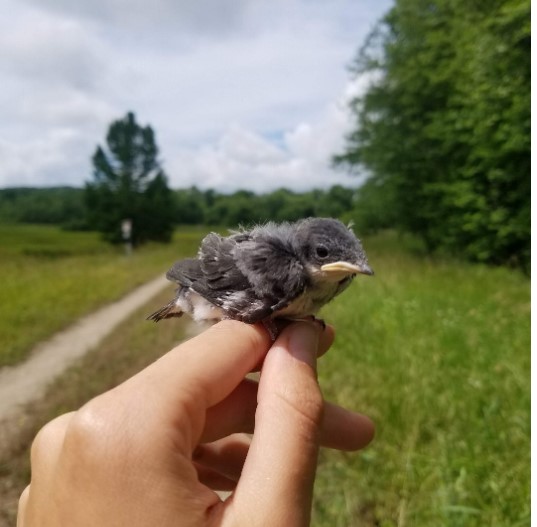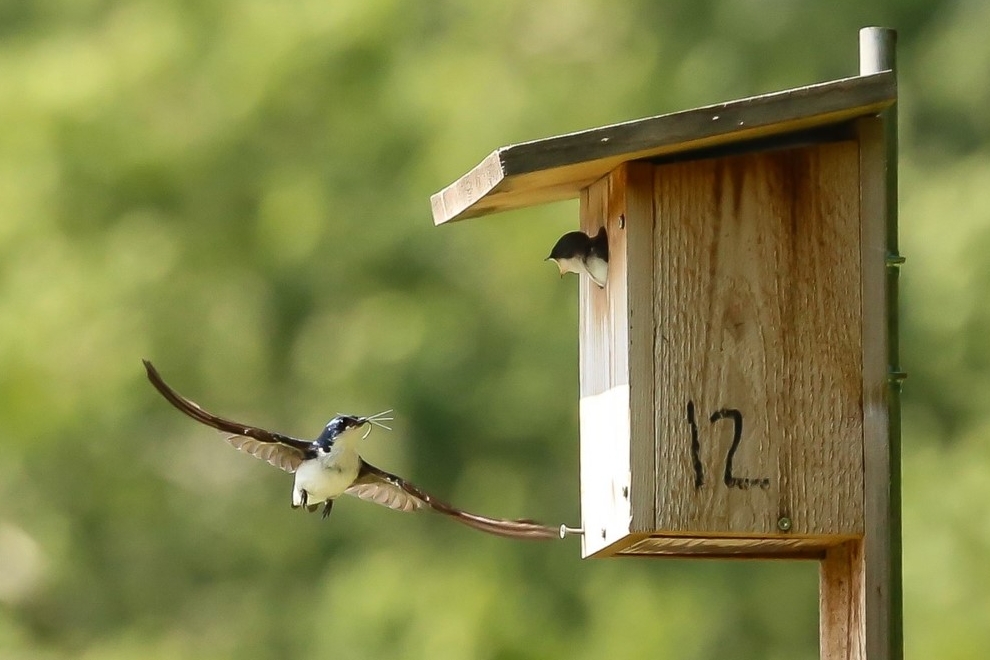Why Are Some Birds Better at Responding to Climate Change Than Others?
By Mary Woodruff, PhD Candidate, Rosvall Lab at Indiana University, Bloomington
No environmental threat is greater than climate change. Rising temperatures, even summer temperatures we commonly experience (~95°F) can negatively affect bird development, survival, and reproductive success. While birds can regulate their internal body temperature, rising global temperatures may push birds to the limit of these thermoregulatory abilities. Researching how wild birds cope with heat will help improve predictions of species persistence. Such predictions could be instrumental in conserving the many birds that face rapidly rising temperatures alongside population declines. This is where Mary Woodruff’s research comes in. Mary is a Biology Ph.D. student in Kim Rosvall’s lab at Indiana University, Bloomington. Mary was awarded a 2022 ABAS Birdathon Grant to fund her research studying thermal tolerance in nestling Tree Swallows.
Tree Swallows are neo-tropical migrants that breed in North America. While the breeding ranges of many species are shifting north or up mountains due to climate change, the Tree Swallow breeding range is expanding south. In the last 30 years, more Tree Swallows have been breeding in states ranging from Indiana to Alabama. Given the expansion into these southern climates with hotter air temperatures, Tree Swallows further south must frequently cope with the heat. But how do they do this?
Faced with environmental challenges, birds generally have two options. At the individual level, they can adapt based on their own pre-existing flexibility, or at the population level, they can evolve genetically over generations via natural selection. The potential for such evolution is determined by the heritability of a trait, a mathematical calculation that evaluates the proportion of trait variation that relates to genetic factors compared to environmental factors. Mary’s research is the first study that explores the heritability of thermal tolerance in a wild bird. Studying the heritability of thermal tolerance is critical for deepening our understanding of avian persistence amidst rising global temperatures.
Mary focuses on one tool that many animals, including humans, use to cope with the heat – heat shock proteins (HSPs). HSPs help prevent cellular damage and promote recovery from stress. The more HSPs an animal produces in response to heat stress, the greater the capacity it has to protect itself. Variation in HSPs can give us an idea of which individuals may be best equipped to handle high temperatures. In her research, Mary measured HSP gene expression in response to experimental heat. Specifically, she compared the response of Tree Swallow nestlings in the same nest (nestmates) and nestlings from different nests (non-nestmates).
To do this, Mary experimentally simulated a hot day inside the nest boxes of wild 12-day-old nestling Tree Swallows. Nests were heated ~7°F above unheated nests, for 4 hours using air-activated warmers such as big hand-warmers. At the end of the experiment, Mary collected blood samples from nestlings in heated and unheated nests for measuring HSP gene expression back in the lab at Indiana University.
Mary observed that HSP responses were more similar among nestmates than non-nestmates. Given that nestmates shared the same thermal environment and also only share 25-50% of their genetics, we can speculate that there may be heritable individual differences in HSP responses. However, she found a lot of variation in heat-induced HSP gene expression. Heated nests had more variation among nestmates and across nests compared to unheated nests. Some of this variation may relate to heat-dumping behavior like panting. In the future, the Rosvall lab plans to measure the amount of nestling panting to see if the variation among nestmates could be due to differences in behavior.
Lower variation in unheated, or baseline, HSPs may reflect past natural selection. Generations of Tree Swallows in the past may have experienced temperatures that shaped baseline HSPs. On the other hand, higher variation in heated nests suggests that there may have been less past natural selection acting on heat-induced HSP responses, possibly because temperatures were not regularly hot enough to induce these high amounts of HSPs. Mild heat challenges may now be necessary for adapting to future climate change temperatures, either by initiating natural selection on heritable differences in heat-induced HSPs or by exposing individuals to challenges that shape their experience and flexible responses.
Ultimately, this study helps us understand why we see survival differences amidst climate change as well as understand how bird populations are able to adapt to environmental challenges. These are metrics essential for long-term conservation strategies. Learning more about how nestlings respond to heat could also inform the design of nest boxes with the aim of minimizing heat stress.
This research was made possible by the generous support of an ABAS Birdathon grant. If you have questions, please email Mary Woodruff at woodrufm@iu.edu. Thank you.
Title photo courtesy of Elizabeth M. George – Tree Swallow feeding begging offspring
Below photo courtesy of Mary J. Woodruff – 12-day-old Tree Swallow


